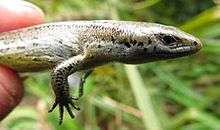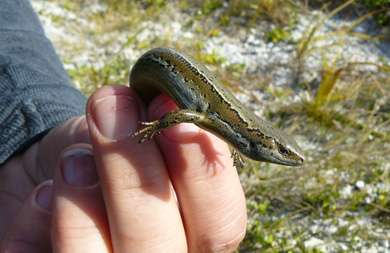Te Kakahu skink
The Te Kakahu skink (Oligosoma tekakahu) is a critically endangered species of skink native to New Zealand. When discovered, the entire species was inhabiting a single patch of clifftop vegetation on Chalky Island in Fiordland National Park.
| Te Kakahu skink | |
|---|---|
 | |
| Scientific classification | |
| Kingdom: | Animalia |
| Phylum: | Chordata |
| Class: | Reptilia |
| Order: | Squamata |
| Family: | Scincidae |
| Genus: | Oligosoma |
| Species: | O. tekakahu |
| Binomial name | |
| Oligosoma tekakahu Chapple, Bell, Chapple, Miller, Patterson & Daugherty, 2011 | |
| Synonyms | |
| |
Discovery
The Te Kakahu skink was discovered in 2002 by members of the Department of Conservation (DOC) kakapo recovery team.[2] Sixteen skinks were collected in 2008, and the species was formally described in 2011 and named Oligosoma tekakahu.[3]
Its species name, tekakahu, comes from the Māori name of Chalky Island, Te Kākahu-o-Tamatea, or "Tamatea's cloak", referring to the oral tradition that this island was where the explorer Tamatea dried his cloak after being drenched by the sea. Although the Māori word kākahu or cloak is spelled with a macron,[4] the skink's name is usually spelled without.[5]
Appearance
Although very similar to the cryptic skink (O. inconspicuum) and the southern skink (Oligosoma notosaurus), the Te Kakahu skink is genetically distinct.[6] It is sturdier and has a comparatively larger head than other related Oligosoma species in the cryptic-skink complex.[7] It is predominantly chestnut brown and glossy with small black markings on its back – either individual flecks or the trace of a mid-dorsal stripe – and a darker stripe down each side.[8] One distinguishing feature are the minimal projecting scales on the interior edge of its small ear opening.[5]
Habitat
This species is recorded as inhabiting just one small site above windswept chalk cliffs on the northwestern coast of Chalky Island, about 130–140 m above sea level.[6][2] Known as "the blowout", this stony area has had most of the soil removed by wind and only has low vegetation. The skinks are centred on a 50 m² patch of low scrub, mostly sedges (Carex), Rytidosperma, and the low-growing shrubs Olearia avicennifolia and O. oporina.[3]
Stoats were not eradicated from the island until 1999, so this is likely to be a last refuge from which the skink population is now expanding.[9][3] It is possible this species still exists in similar habitat on nearby islands or the mainland.[10]
Conservation status

In 2012 the Department of Conservation reclassified the Te Kakahu skink as "Nationally Critical" under the New Zealand Threat Classification System.[11] It met the criteria for Nationally Critical threat status by occupying a total area of less than 1 hectare. The Te Kakahu skink is considered conservation dependent, in partial decline, and found only in one location.[11]
Chalky Island has never had rats, mice, possums, or deer, and since DOC eradicated stoats with a trapping network in 1999 it has been free from introduced mammalian predators.[12] Te Kakahu skinks are only preyed on by New Zealand falcons (Falco novaezeelandiae). The skinks are active in daytime, sunbathing for long periods, and display little fear of novel species.[3] The single population of skinks remain vulnerable, as an arrival of stoats or an accidental fire would threaten the entire species.[13][9]
Conservation efforts
In February 2013 DOC staff counted and studied a total of 160 skinks from the Chalky Island site, ageing, sexing, and measuring each individual.[9][14] A follow-up survey in February–March 2016 confirmed that a relatively abundant population existed to support a harvest of skinks for translocation.[10][13] A release site was chosen on nearby predator-free Anchor Island, and 99 skinks were transferred in February 2018. Every skink was photographed and its unique scale patterns noted. Anchor Island is home to several endangered birds, such as kakapo, little spotted kiwi, and mohua, but has no other skink species.[13]
References
- Hitchmough, R.; van Winkel, D.; Lettink, M. (2019). "Te Kakahu Skink: Oligosoma tekakahu". IUCN Red List of Threatened Species. 2019: e.T120190180A120192689. doi:10.2305/IUCN.UK.2019-2.RLTS.T120190180A120192689.en.
- "Te Kakahu skink". Department of Conservation. Retrieved 23 Feb 2018.
- Chapple, David G.; Bell, Trent P.; Chapple, Stephanie N. J.; Miller, Kimberly A.; Daugherty, Charles H.; Patterson, Geoff B. (2011). "Phylogeography and taxonomic revision of the New Zealand cryptic skink (Oligosoma inconspicuum; Reptilia: Scincidae) species complex" (PDF). Zootaxa. 2782: 1–33.
- "kakahu". Māori Dictionary. Retrieved 2018-02-22.
- "Oligosoma tekakahu Chapple, Bell, Chapple, Miller, Daughety & Patterson, 2011". The Reptile Database. www.reptarium.cz. Retrieved 18 July 2015.
- "Oligosoma tekakahu". The Department of Conservation. The Government of New Zealand. Retrieved 19 July 2015.
- Morris, Rod. "New Zealand Frogs & Reptiles". Rob Morris. Rob Morris. Retrieved 20 July 2015.
- Jewell, Tony (2011). A photographic guide to reptiles and amphibians of New Zealand (2nd ed.). Auckland: New Holland. p. 89. ISBN 978-1-86966-203-5.
- "Rare lizard thriving on Chalky Island". Department of Conservation. 20 May 2016. Retrieved 23 Feb 2018.
- Edmonds, Hannah; Loe, Erina. "Te Kakahu skink population estimate". www.doc.govt.nz. Government of New Zealand. Retrieved 22 May 2016.
- Hitchmough, Rod; Anderson, Peter; Barr, Ben; Monks, Jo; Lettink, Marieke; Reardon, James; Tocher, Mandy; Whitaker, Tony. "Conservation status of New Zealand reptiles, 2012" (PDF). Department of Conservation. The Government of New Zealand. Retrieved 18 July 2015.
- "Tieke/Saddleback transfer to Chalky Island". Fiordland Conservation Trust. April 2008. Retrieved 2018-02-23.
- "Big horizons for little skink". Department of Conservation. 15 February 2018. Retrieved 23 Feb 2018.
- "Rare lizards on Chalky Island". Behind the Scenes (7): 4. Autumn 2013. Retrieved 19 July 2015.
Further reading
- Loh, G. 2003: Te Kakahu skink hunt. Otago Conservancy, Department of Conservation (unpublished).
External links
| Wikimedia Commons has media related to Category:Oligosoma tekakahu. |
| Wikispecies has information related to Oligosoma tekakahu |
- Te Kakahu skink discussed on RNZ Critter of the Week, 23 February 2018
- Photographs of the Te Kakahu skink
- Image of a Te Kakahu skink
- Image of the holotype specimen held at Museum of New Zealand Te Papa Tongarewa
